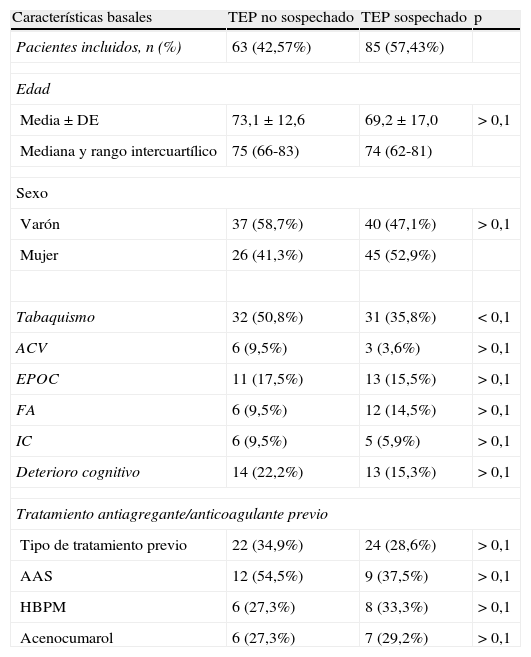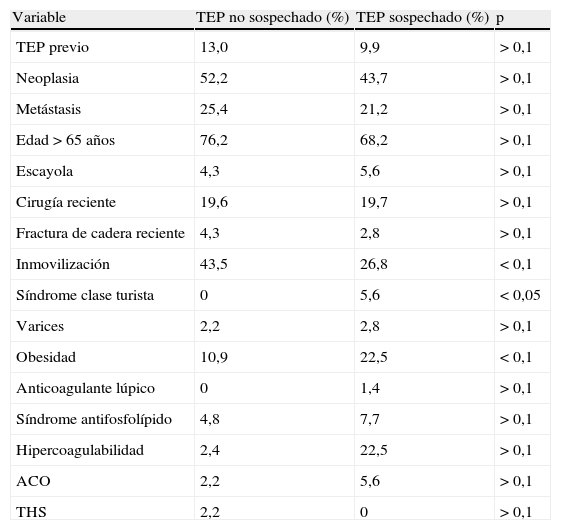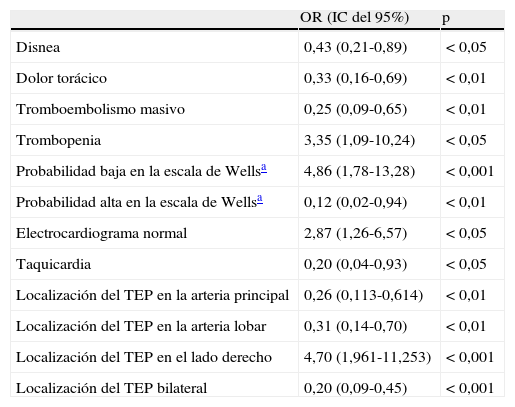El tromboembolismo pulmonar (TEP) es una enfermedad que en ocasiones, se diagnostica con un elevado retraso, lo que puede provocar una mayor morbimortalidad. Hemos definido el perfil clínico de los pacientes con TEP no sospechado en el Servicio de Urgencias, y los factores que influyen en el retraso para establecer el diagnóstico de TEP.
Pacientes y métodosSe analizaron retrospectivamente 148 pacientes ingresados con diagnóstico de TEP confirmado mediante TAC (n=133) o gammagrafía de ventilación/perfusión de alta probabilidad (n=15). Fueron divididos en dos grupos: los que no tenían sospecha diagnóstica de la enfermedad en el Servicio de Urgencias (TEP no sospechado) y aquellos en los que sí se sospechó este proceso (TEP sospechado). Se estudiaron las características clínicas, los factores de riesgo, los signos y los síntomas a su llegada a Urgencias; las pruebas complementarias realizadas, los días de ingreso hospitalario y la mortalidad.
ResultadosDe los 148 enfermos con TEP, el diagnóstico no se sospechó en el Servicio de Urgencias en 63 pacientes (42,6%). La disnea y el dolor torácico fueron las manifestaciones clínicas más comunes y se identificaron con mayor frecuencia entre los enfermos con TEP sospechado, que entre los pacientes con TEP no sospechado, con diferencias significativas (OR=0,4 [0,2-0,9] para la disnea y OR=0,3 [0,2-0,7], para el dolor torácico). Sin embargo, la presencia asociada de trombopenia (OR=3,4 [1,1-10,2], p<0,05), un electrocardiograma (ECG) normal (OR=3,4 [1,1-10,2], p<0,05), y la localización del TEP en pulmón derecho (OR=4,7 [2-11,3], p<0,001), fueron factores asociados a la no sospecha de la enfermedad. Los días de ingreso y de duración de los síntomas, así como la mortalidad, no fueron estadísticamente diferentes entre ambos grupos.
ConclusionesLa proporción de enfermos con TEP confirmado pero no sospechado en el Servicio de Urgencias fue elevada (cerca del 40%). La presencia de disnea y dolor torácico se asociaron a la sospecha de TEP. Por el contrario, la presencia de trombopenia, un ECG normal, y la localización del TEP en el pulmón derecho se asociaron a la no sospecha de TEP en urgencias.
Pulmonary embolism (PE) is a disease that sometimes has a significant delay in diagnosis. This situation may lead to an increase in morbidity and mortality in patients who have it. The aim of our study has been to define the clinical profile of patients with unsuspected PE in the emergency department and the factors that influence the delayed diagnosis.
Patients and methodsA total of 148 patients admitted with diagnosis of PE confirmed by CT (n=133) or by high-probability ventilation-perfusion scintigraphy scan (n=15) were retrospectively analyzed. They were divided into two groups: those with unsuspected disease in the emergency department (USPE) and those who it was suspected (SPE). Baseline characteristics of the patients, risk factors, signs and symptoms in the emergency department, complementary test, days of hospitalization and mortality were studied.
ResultsThe USPE was found in 63/148 patients (42.6%) in the emergency department. Dyspnea and chest pain were the most frequent clinical manifestations of this disease, this being more commonly identified in the SPE group than in the USPE group, with significant differences (OR=0.4 [0.2-0.9] for dyspnea and OR=0.3 [0.2-0.7] for chest pain). However, However, the presence of thrombocytopenia (OR=3.4 [1.1-10.2], P<.05), normal electrocardiogram (EC) (OR=3.4 [1.1-10.2], P<.05), and localization of PE in right lung (OR=4.7 [2-11.3], P<.001) were risk factors for not suspect it. Days of hospitalization, days of symptoms and mortality were not statistically different between groups.
ConclusionsAccording to the results, the proportion of unsuspected PE in the emergency department was high (close to 40%). The presence of dyspnea and chest pain was associated to suspicion of SPE. On the contrary, the presence of thrombocytopenia, normal EC and right localization of PE were associated to the non-suspicion of SPE in the emergency department.
Article
Diríjase desde aquí a la web de la >>>FESEMI<<< e inicie sesión mediante el formulario que se encuentra en la barra superior, pulsando sobre el candado.

Una vez autentificado, en la misma web de FESEMI, en el menú superior, elija la opción deseada.

>>>FESEMI<<<









